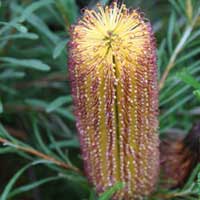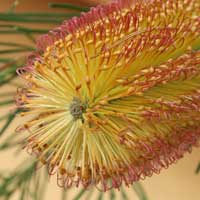
Some of the most widely grown native plants are the Banksia species. Attractive long lasting flowers, easy care and a number of varieties from low growing to large shrubs or small trees, make this a versatile genus.
Species such as B. integrifolia, B. spinulosa and B. marginata are an Australian woody evergreen plant that can be found as a tall tree, or in a low growing prostrate form.
Flowers form as a cylindrical form, dense and very colorful. Flowers range from yellow through to dark purple. B. integrifolia and B. spinulosa (picture right) are popular species readily available for sale from specialist Australian Plant Nurseries.
Named after Sir Joseph Banks. With 76 species, these attractive long flowering plants produce stunning flowers and can add colour to any garden. Banksia are a great plant for attracting birds, prefer a well drained sunny position and can be kept in shape with light regular pruning.
List Of Banksia Varieties
The Western Australian Banksias.
Some of the best flowering varieties are from Western Australia. These species in particular require a very well drained soil or may succumb to root diseases. Fortunately grafted versions of these plants are becoming more common in the eastern states.
B. coccinea with its brilliant red flowers is perhaps the best example of this. If you could grow one species for the flowers, this would be the one for us.
Dwarf Banksias
A number of low growing or prostrate forms that will reach around 50cm are also available, including cultivars such as :
- ‘Birthday Candles’
- Banksia coccinea- Scarlet banksia
- Coastal Cushion – Low Growing
- ‘Little Eric’
- ‘Cherry Candles’
- ‘Stumpy Gold’
- B. ericifolia (A very attractive variety)
- B. blechnifolia can be used as a ground cover plant
Popular species and varieties of include: B. aemula or Wallum Banksia, B. ‘Giant Candles’, B. ericifolia, B. integrifolia, B. robur and B. spinulosa.
B. ericifolia Dwarf form is early flowering species with attractive red flowers, a little taller than other dwarf forms reaching around 1.5m depending on conditions.
The larger growing and long flowering B. ericifolia or Heath Banksia will reach around 3m
B. integrifolia or Coast Banksia and B. serrata Saw or Old Man Banksia are larger growing species that will reach up to 10m
Basic Banksia Care
These are a hardy tree or shrub and require little water once established in the garden. Like many native plants they require excellent drainage and do well in full sun.
Prune spent flower heads to maintain shape, regular light pruning will increase flower production, heavy pruning or cutting back into wood with no growth is not advisable.
Some of the dwarf cultivars make excellent potted plants a free draining potting native plant mix is best. Fertilize potted plants with a slow release Australian Native Plant Fertilizer (these are low phosphorous).
- Sunny position.
- Well drained soil.
- Mulch to maintain a cool root run and even soil temperature.
Most species can be pruned, and the best way is to simply remove the spent flower heads. If you cut back to hard into old wood the plant may not re shoot.
Banksias for use as ground cover plants
- B. chamaephyton Fishbone Banksia is a prostrate spreading shrub reaching .5m and spreading over 1m
- B. gardneri Creeping Banksia (formerly B prostrata)
- B. integrifolia (Coastal Banksia) prostrate forms including the yellow flowering Banksia ‘Roller coaster’
- B. paludosa prostrate forms of the marsh or swamp banksia handles wet conditions better than most
- B. petiolaris
- B. repens another from western Australian also known as ‘Creeping banksia’.
- B. serrata which is also available as a prostrate form, the yellow and pink tinged spring flowering B. ‘Pygmy Possum’ is a compact form that has a spread of 2m.
You may also be interested in
470 Monbulk-Silvan Road Monbulk VIC 3793
"Guaranteed mail order flowering bulbs, perennials, roses, trees, landscaping plants, garden accessories and community fundraising Austra lia-wide."
www.gardenexpress.com.au


